This homemade vegan Italian cannoli recipe will take you straight to Sicily, the motherland of authentic cannoli siciliani.
Our filling is made of vegan homemade ricotta and is sweet and creamy. The shell is every bit as bubbly, light, and crisp as the traditional ones, but without eggs, lard, or butter.
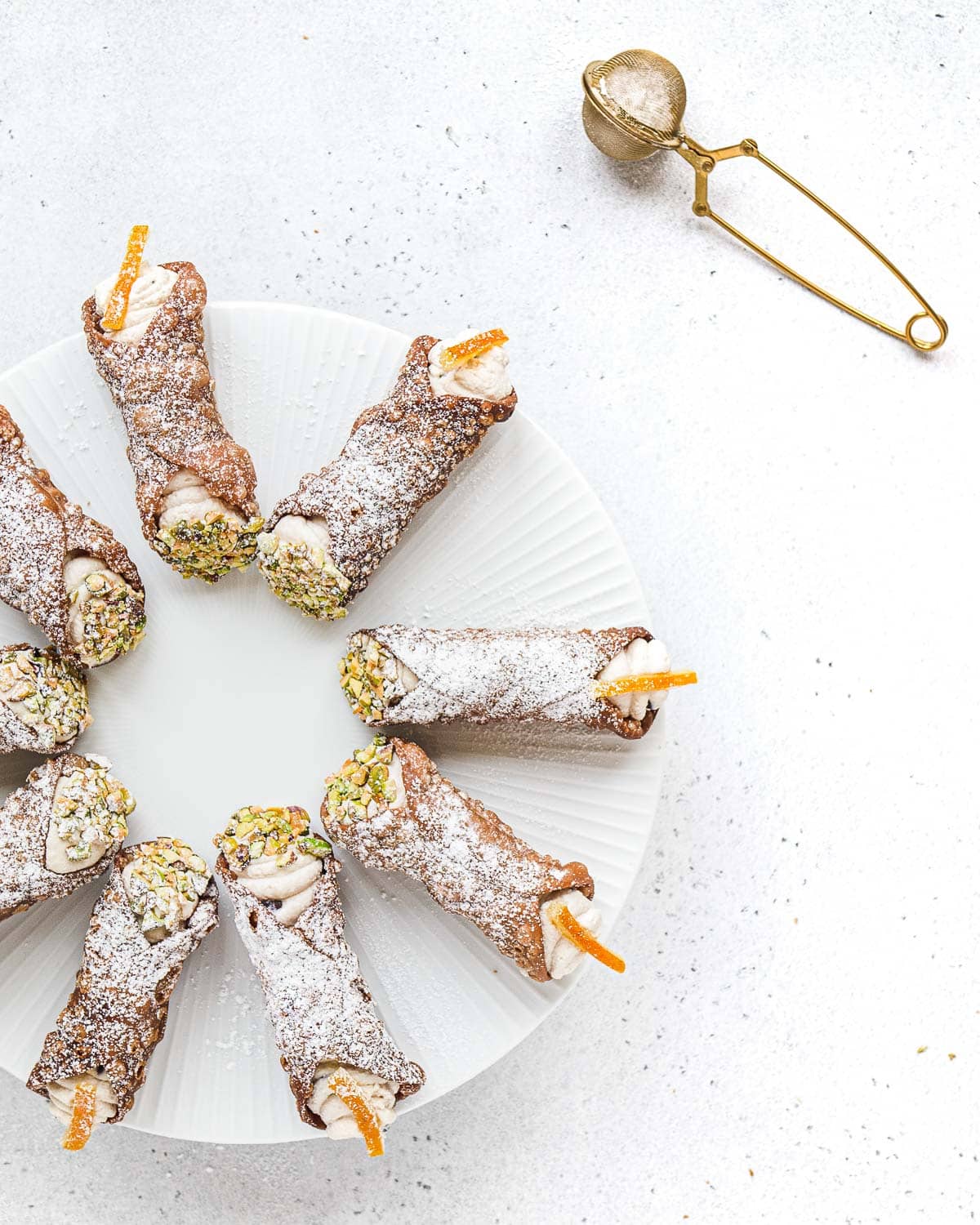
Check out our best Italian recipe collection!
What to expect
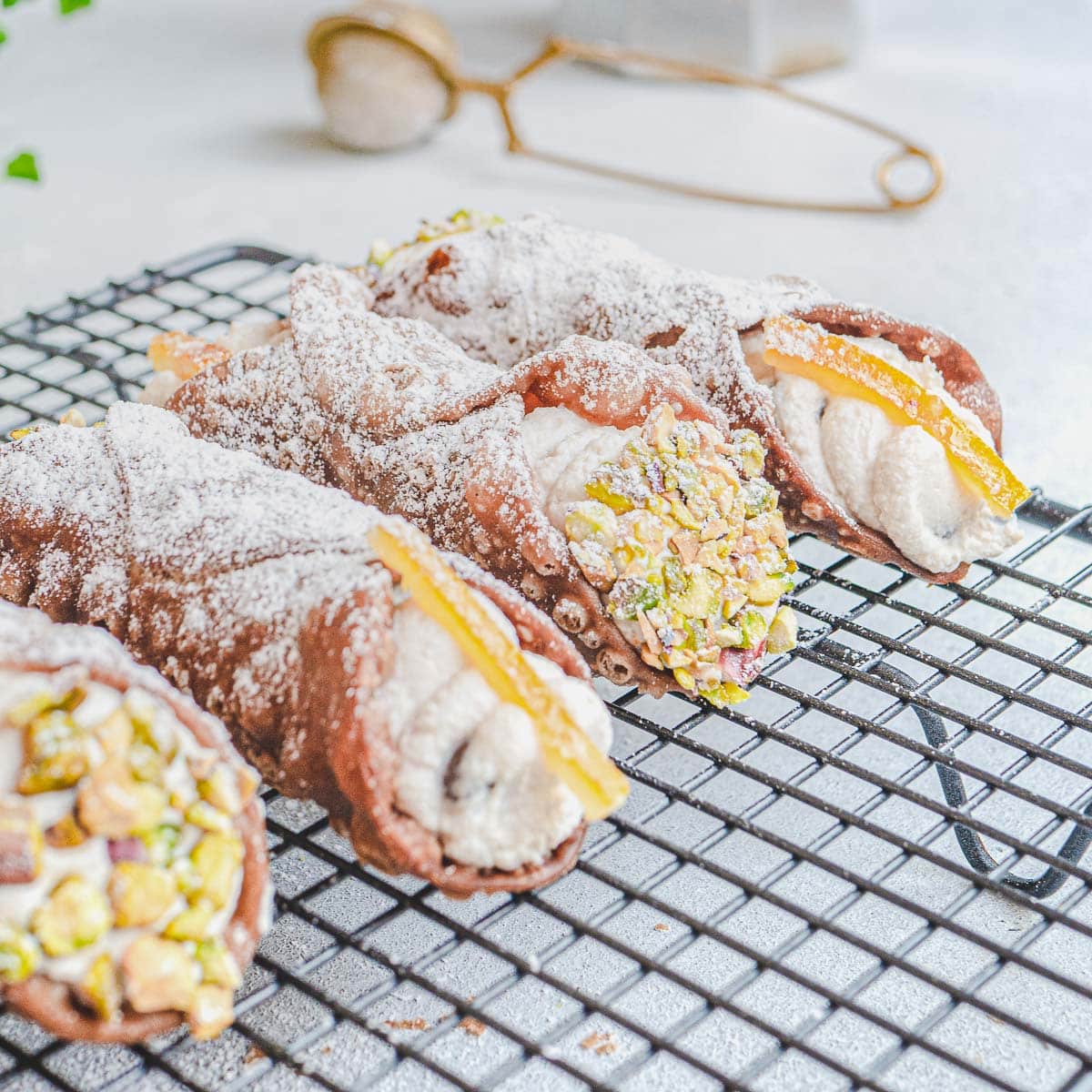
Our vegan cannoli will not disappoint. We promise. This recipe has been perfected over time to recreate the flavor and texture of authentic Sicilian cannoli.
We make the filling with our homemade soy ricotta, which is very easy to make with 3 ingredients. The ricotta flavor is neutral and mild, perfect to be used as a filling for cannoli.
The cannoli shells are also very simple and turn out crunchy and bubbly, and practically exactly like original cannoli shells. If you decide to make this recipe, you are in for a real treat.
Ingredients & Substitutions

Ingredients for the vegan ricotta
- Soy milk: we tested over 25 brands of soy milk and they all worked to make this ricotta. For this recipe, you can use either sweetened or unsweetened soy milk.
- Vinegar: regular white vinegar, apple cider vinegar, or lemon juice.
- Salt: to neutralize the flavor of the vinegar.
Ingredients for the vegan cannoli filling
- Vegan ricotta.
- Sugar: use regular white sugar for authentic cannoli taste and texture. You could replace it with other sweeteners, like brown sugar, or syrups.
- Dark chocolate chips: get the small ones that look like little drops.
- Grated orange zest: in some Sicilian recipes you find orange zest, in others you don’t. We like to add some.
Ingredients for the vegan cannoli shell
- Flour: use cake flour to get a shell that is light and crisp like the traditional cannoli shell. You could replace it with other less refined flours.
- Sugar: we use regular sugar.
- Fat: we use our homemade margarine for this recipe. We make it by blending together 100 ml of sunflower seed oil and 50 ml of soy milk. You can also use store-bought margarine or vegan butter.
- Marsala or wine: marsala, a fortified Sicilian wine, is used in most authentic Sicilian cannoli recipes. But marsala is hard to find outside of Italy. Some people use wine, sometimes red, sometimes white, depending on the local tradition in Sicily. We tested all recipes, and our best result was sweet red wine. It’s easier to find than marsala, it’s cheaper, and it yields a great result making the shells light and full of bubbles.
- Cacao powder and cinnamon: we use them to give color and aroma to the dough.
- Oil for frying: in the traditional cannoli recipe, people fry the cannoli in lard. Since our cannolis are vegan, we do them without lard, and instead, we fry them in vegetable oil. We use sunflower or peanut oil.
Ingredients for the cannoli toppings
- Pistachios: unsalted and crushed.
- Candied orange peel: you can also add candied cherries.
- Powdered sugar: used to sprinkle on top, makes the cannoli extra cozy and delicious.
Equipment
- Cheesecloth: to filter the ricotta. You can replace it with a clean and white kitchen cloth. Just make sure it doesn’t smell like washing detergent.
- Cannoli forms/tubes: you can find them on amazon. You can replace them with homemade tubes, made with rolled aluminum paper, wrapped in parchment paper. But it’s going to be a bit of a project, you’ve been warned 🙂
- Round pastry cutters: you can replace them with a knife.
- Pastry piping bag: to help you fill the cannoli, you can also use a spatula.
- Rolling pin: you could use a pasta-making machine to roll the dough, but we prefer the rolling pin.
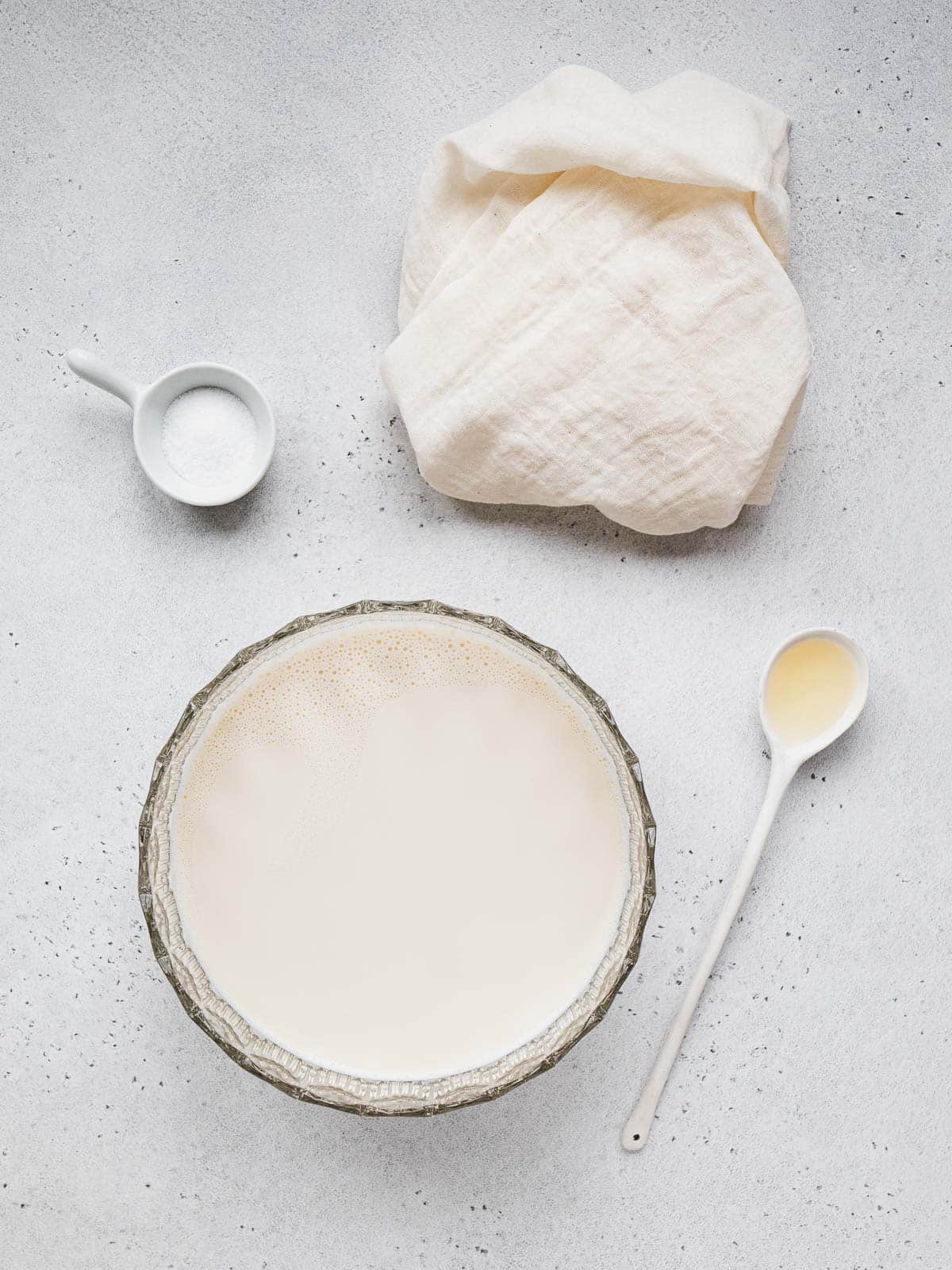
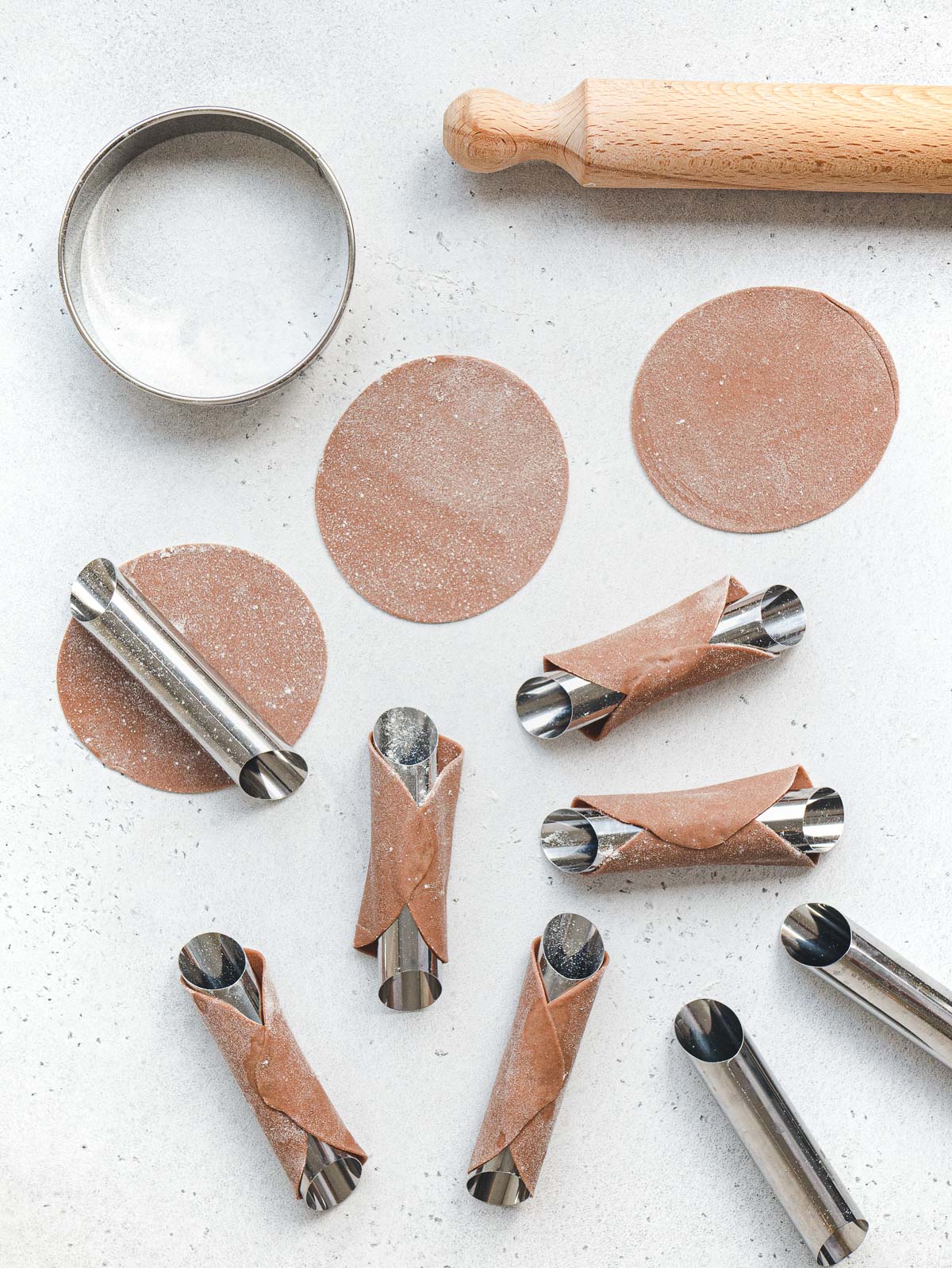
Instructions
Make the cannoli shells
For this cannoli recipe, we start by making a simple dough. To do that, add flour, sugar, cacao powder, and cinnamon to a bowl and mix well with a spatula. Now add softened vegan butter (or margarine), the marsala wine (or sweet red wine), and the water. Mix with a spatula till you have a dough ball.
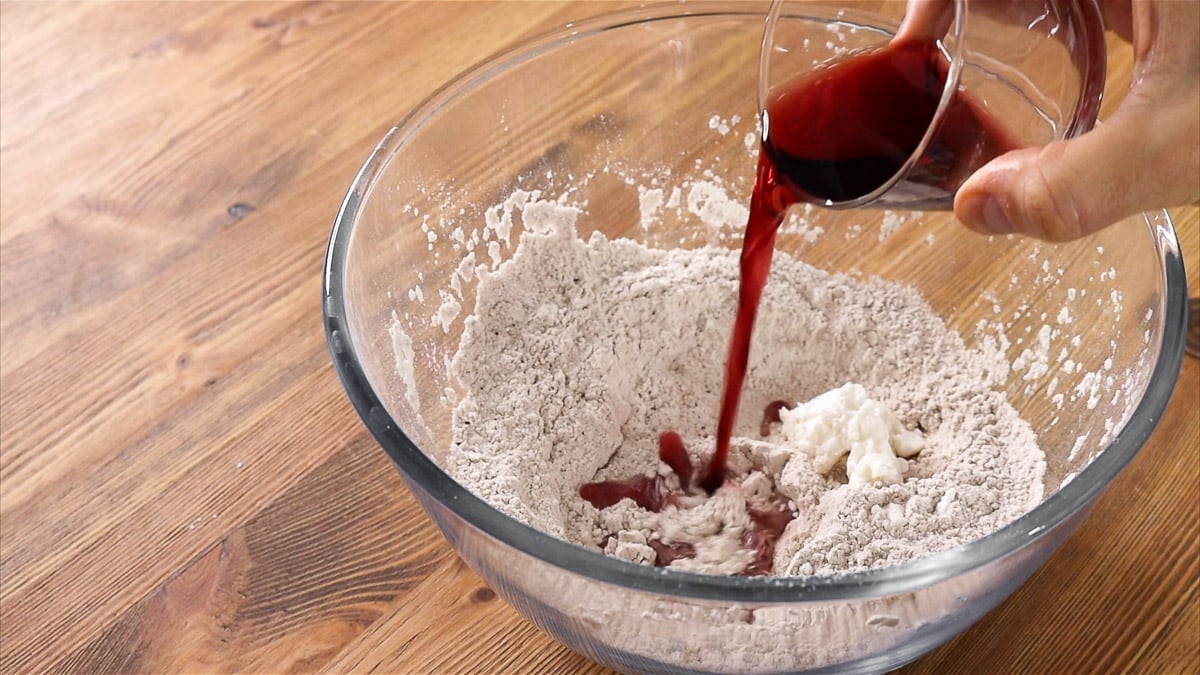
Then, on a worktop, knead the dough ball for about 5 minutes. You should have a smooth dough ball, with a soft consistency, but not sticky. If it’s too wet and sticky, add some flour to the worktop and keep kneading until it doesn’t stick to your hands.
Now you can let it rest in a bowl, covered with a plate, for 30 minutes. TIP: when resting, the gluten in the dough relaxes, making it easier for you to roll, and lighter to eat.
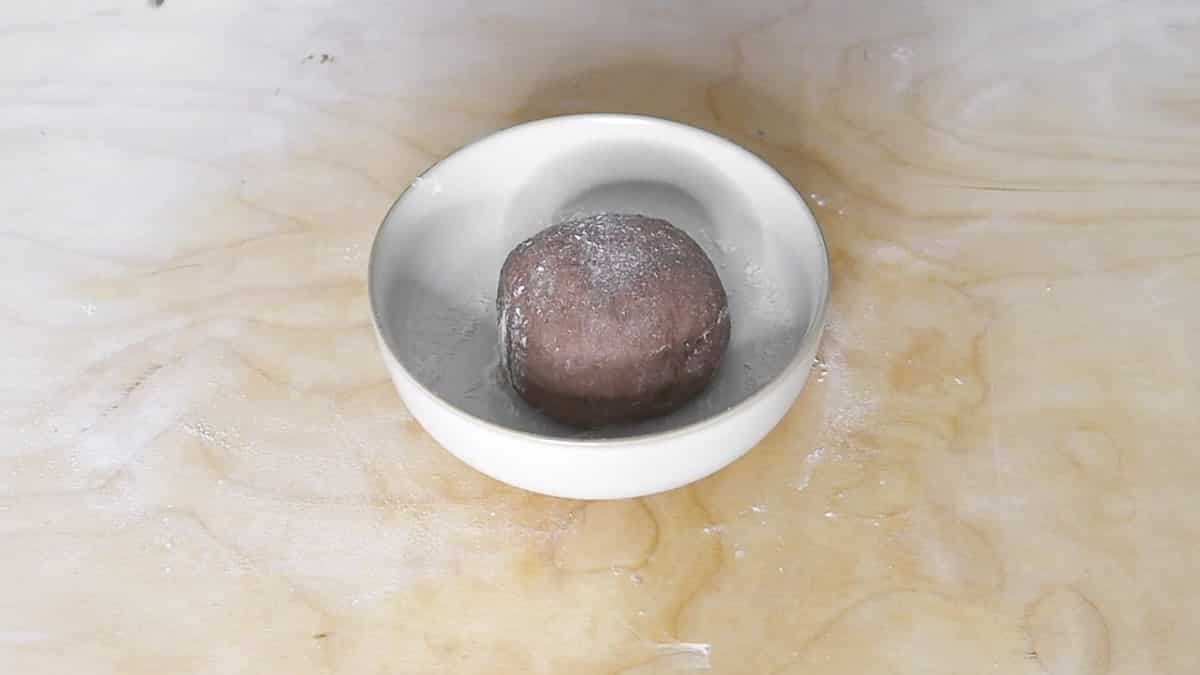
After 30 minutes of resting, you can start rolling the dough with a rolling pin. Dust the worktop and the rolling pin with flour to prevent the dough from sticking.
While rolling, fold the dough on itself 5 to 10 times before flattening it completely. This will make the cannoli shell lighter and full of little bubbles. You should aim for a thin dough, of about 1 to 2 millimeters.
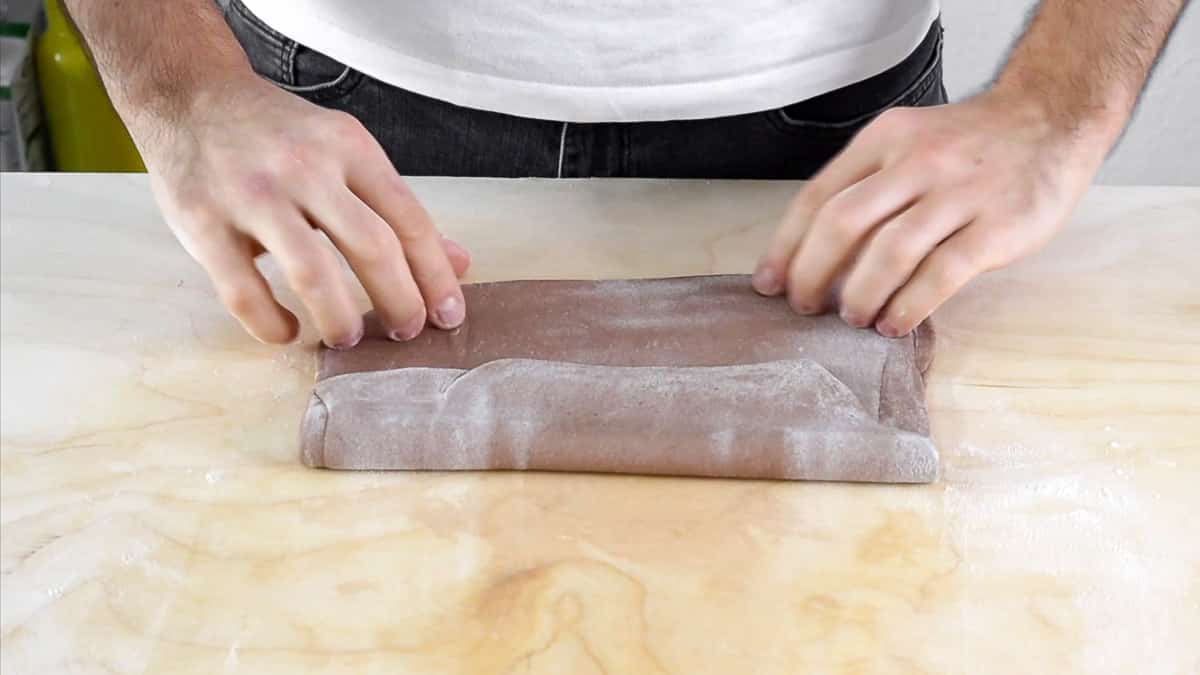
Now cut the dough into squares or circles, of the length of the cannoli tubes and wrap the cut dough around the cannoli tubes. Then wet the edges with some water before sealing the cannoli dough. Make sure the cannoli are well sealed, or they’ll open up while frying.
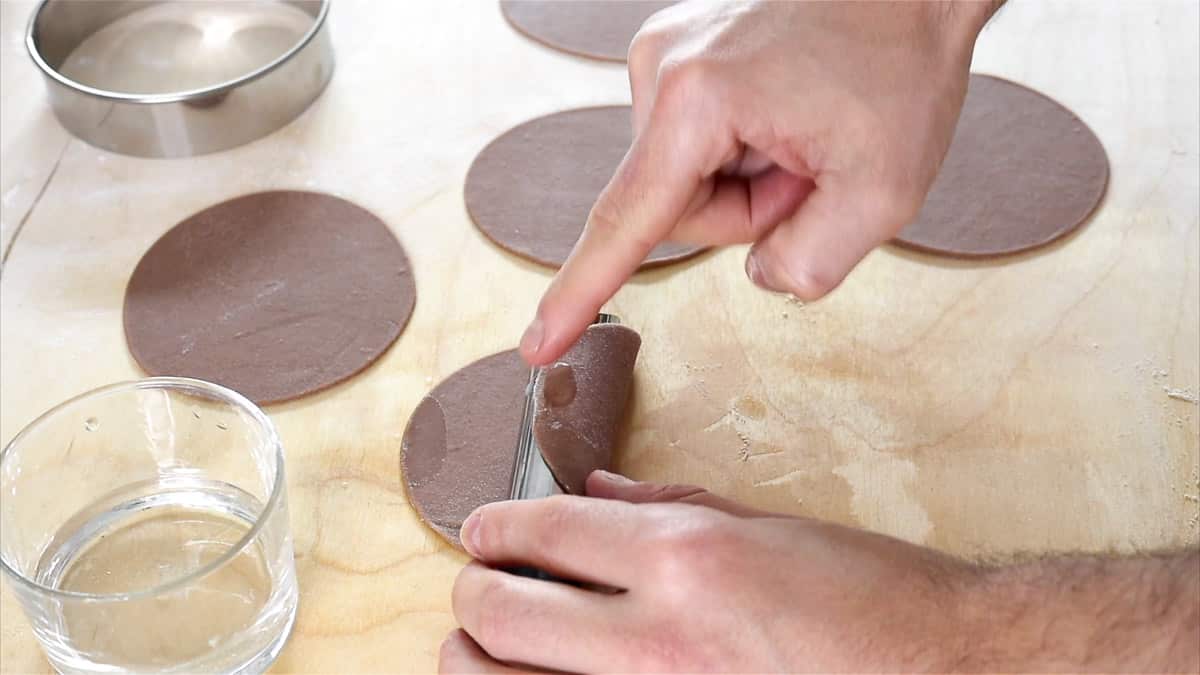
Fry the cannoli shells
Before you start frying, remember that hot oil and water should never come into contact. So please be careful. Now, add the frying oil to a pot. Don’t fill the pot with oil completely, only half. The pot should be small, but big enough to comfortably fit one cannoli plus the frying oil.
Bring the oil to temperature. It should reach 180°C (360°F). The best way to check if the oil has reached temperature is with a thermometer. If you don’t have one, dip the tip of a wooden spoon in the oil. When it starts to bubble, the oil is ready. If the oil smokes, it means it is too hot, and it’s burning. That’s not healthy.
TIP: make sure the temperature of the oil stays at around 180°C (360°F). If it’s too low, the shells will absorb oil. If it’s too high, the shells will burn.
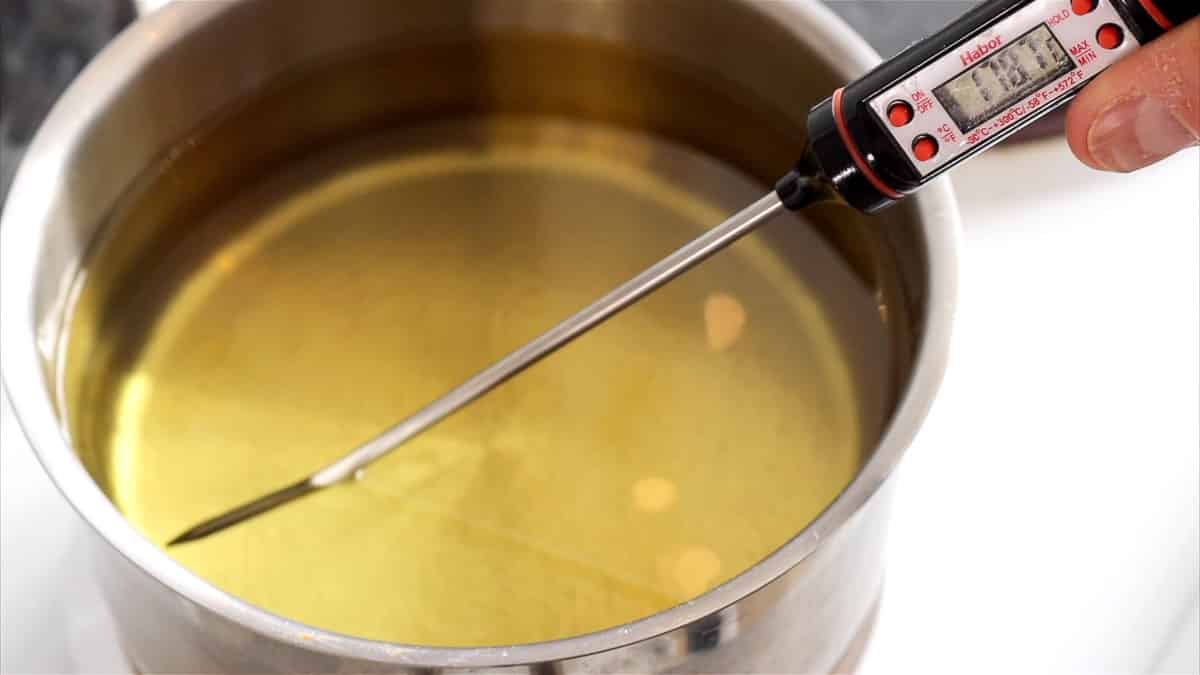
Now you can fry the cannoli, one by one. It takes about 1 minute for each cannolo. Turn them around while frying so that they cook evenly.
TIP: if you see that the cannoli break away from the forms while frying, then give the next ones a squeeze with your hands to tighten them up around the forms, before dipping them in the frying oil.
When the cannoli turn light brown, take them out of the oil, let drip the excess oil, and place them on a cooling rack on some kitchen paper. They’ll darken when cooling.
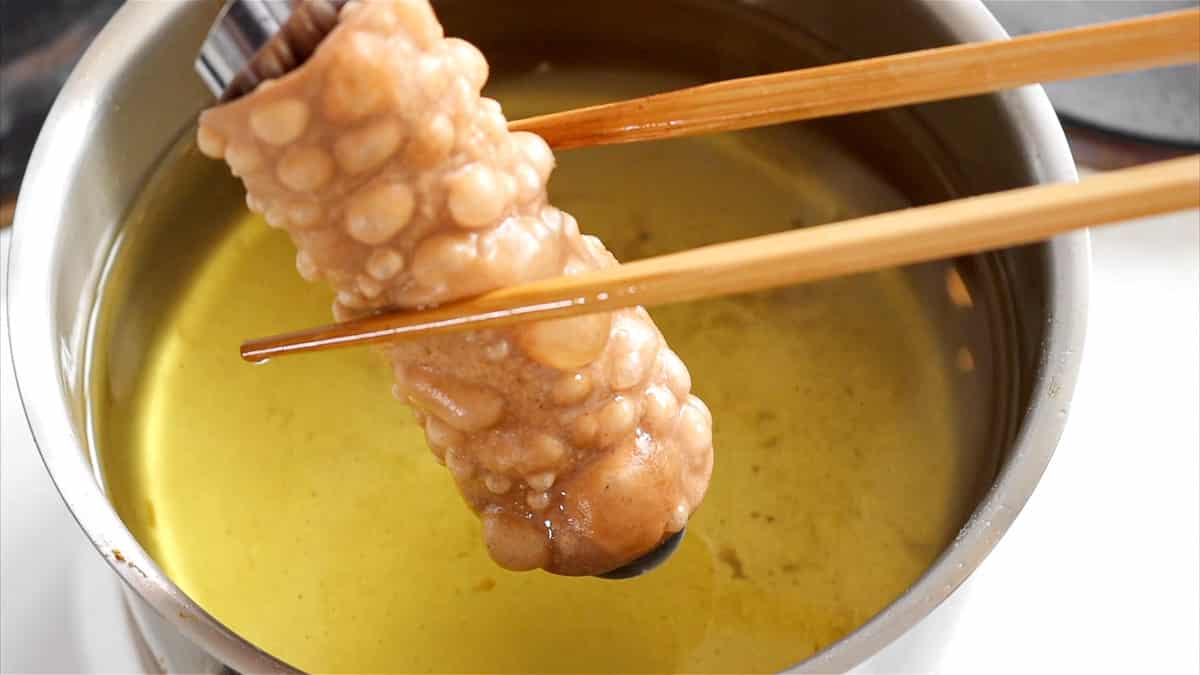
When cooled, gently remove the forms and get ready to fill up the cannoli shells. Only fill up the shells once they are completely cooled.
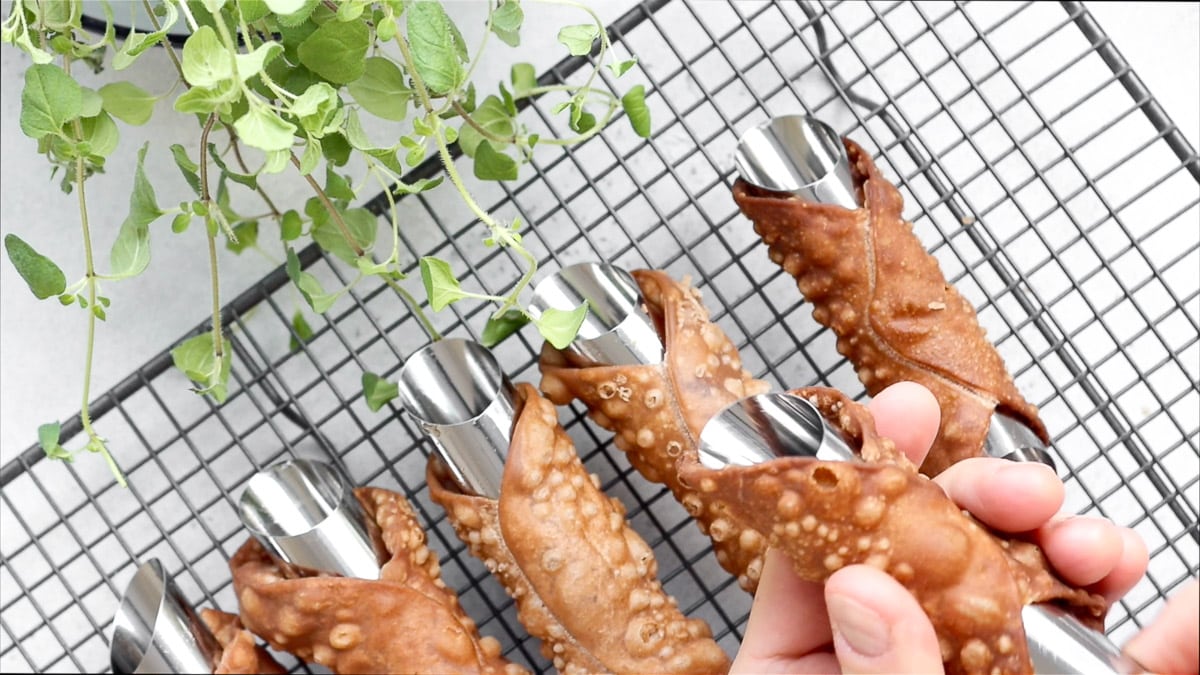
Make the cannoli filling
In a bowl, add the vegan ricotta, sugar, vegan dark chocolate drops, and a tiny bit of orange zest. Use a spatula to gently mix. Do not over-mix.
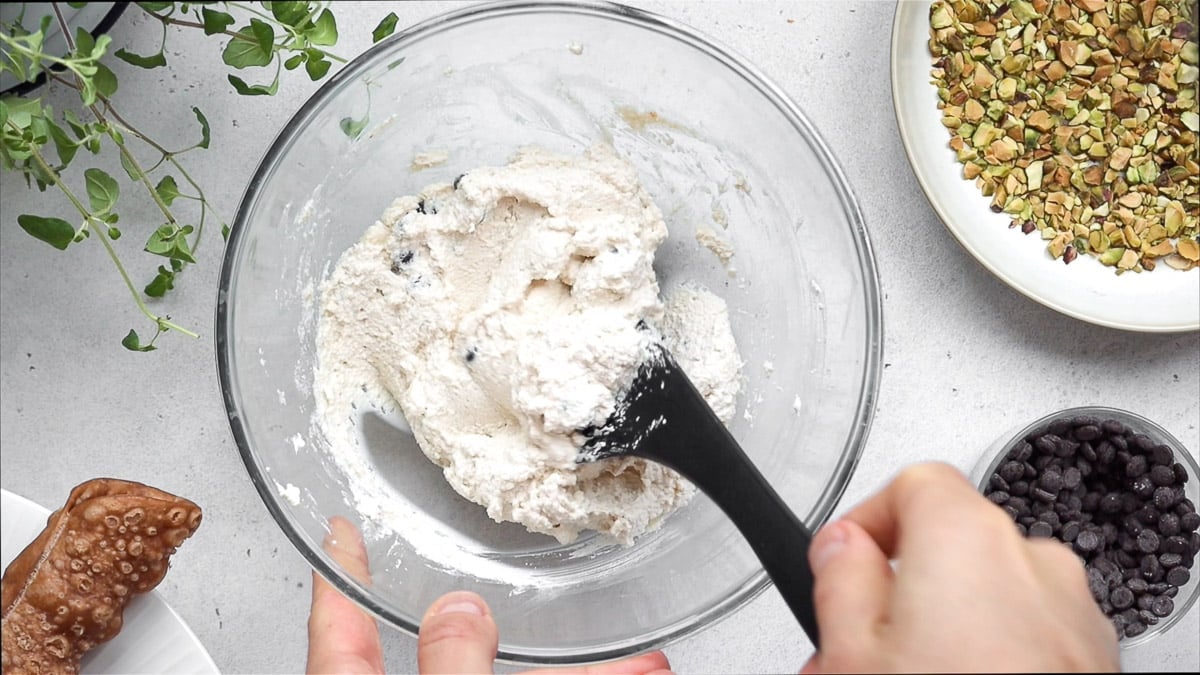
Put the ricotta cream into a pastry piping bag and start filling the cannoli one by one. Fill each cannolo from both sides, starting from the middle and moving outwards, while filling.
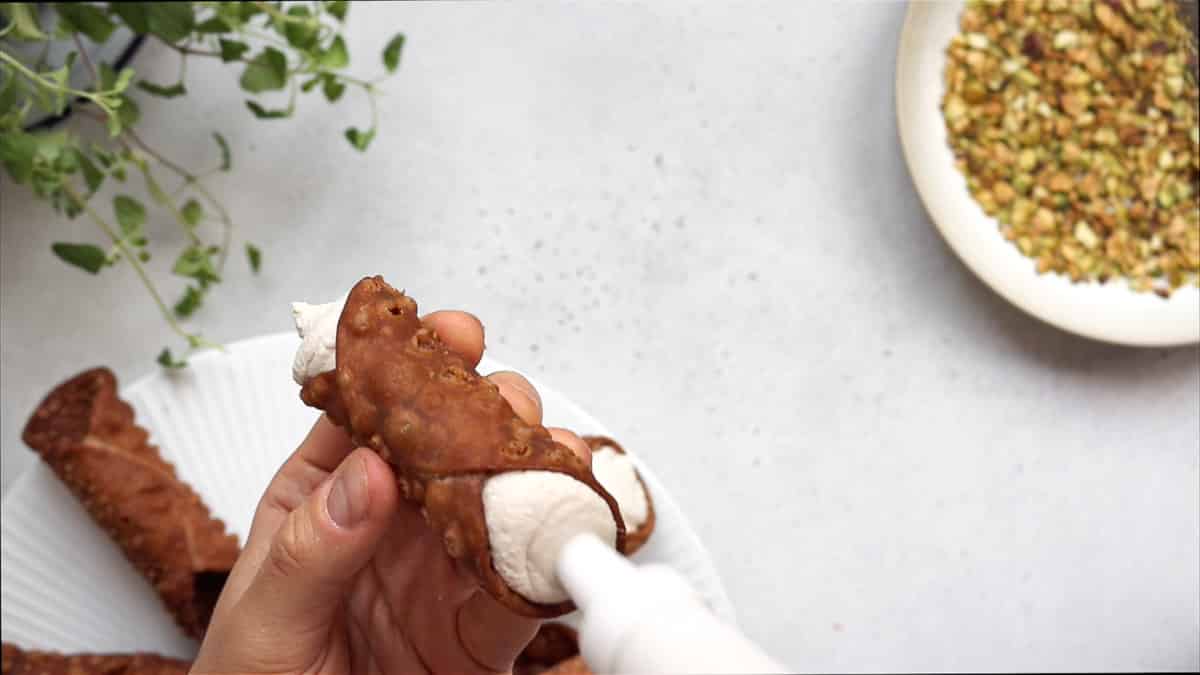
Dip one end of the cannoli into some crushed pistachios, and top the other end with candied orange peel or half a candied cherry.
Arrange on a serving platter, sprinkle with powder sugar and enjoy.TIP: Use the leftover dough to make some cannoli nachos. Flatten it, then cut it into triangles, fry it, and serve it with a side of cannoli filling dip. See our variations section.
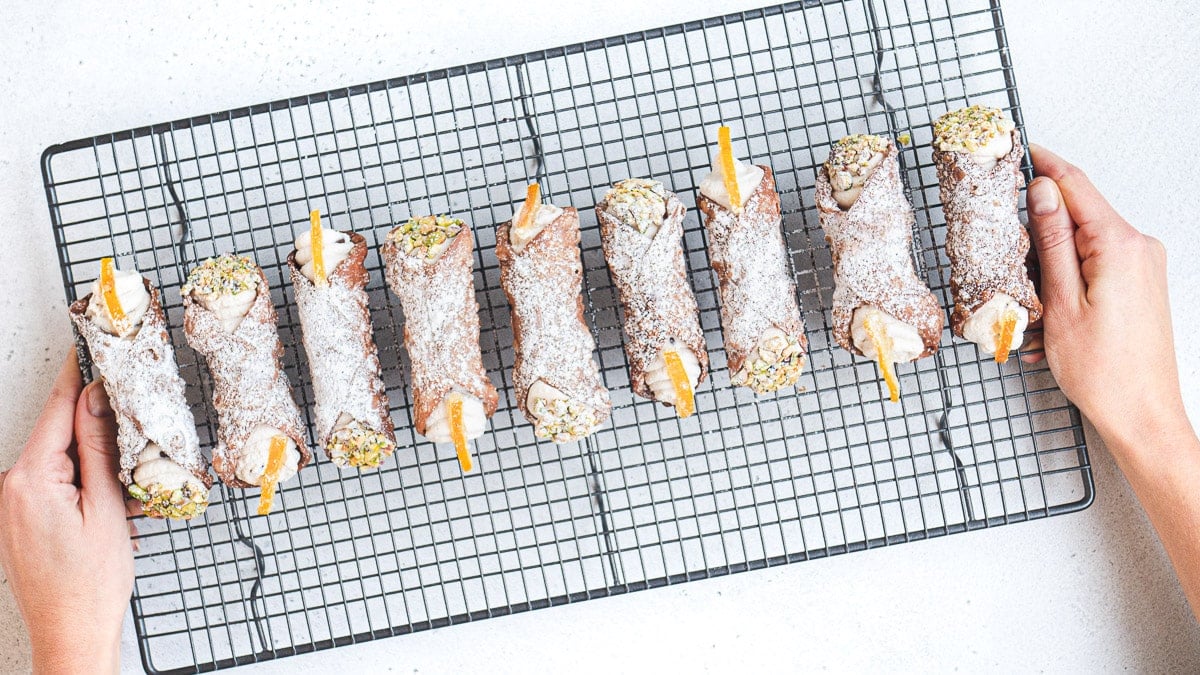
Tips
- Drain the ricotta well: drain the ricotta for about 30 minutes with a weight on top so that the ricotta is drier and the cannoli shell doesn’t get soggy. I use a bowl filled with water to add weight.
- Fold the dough: a tip to make a light, crisp and bubbly dough, is to fold it several times while rolling it. Do that 5 to 10 times and you will get a vegan cannoli shell that is as delicious, light, and crisp as the nonvegan one.
- Roll it thin: roll the dough for the cannoli shell 1 millimeter thin if you can. You can do so with the help of a pasta machine, or simply with a rolling pin. Doing so will produce a cannoli shell that will fry faster, will be lighter, and absorb less oil.
- Seal them well: admittedly my first cannoli shell was a disaster. It opened up completely while frying. To avoid that mistake, seal the edge of the cannoli with a bit of water, then lightly squeeze the dough around the cannoli tube with your whole hand.
- Fill just before serving: if it stays too long in the shell, the filling will make the cannoli soggy. So fill them up at the last minute, just before eating them.

Questions
Traditional cannoli filling is made of “ricotta di pecora”, a soft Italian cheese made of curdled sheep’s milk. Our vegan cannoli filling is made of curdled soy milk. Trust us, it’s as delicious, if not better, than the traditional ricotta.
You can use bamboo canes or rolled-up aluminum foil, wrapped in parchment paper.
Yes. You can make vegan Italian cannoli without lard as we do in our recipe. Just use margarine, vegan butter, or regular vegetable oil like sunflower seed oil.
Yes. You can replace wine with half water, half vinegar. We recommend adding either wine or vinegar to make your cannoli shells bubble, just like the authentic Sicilian cannoli recipe.
Variations
- Chocolate shell cannoli: dip the edges of the cannoli shell into melted dark chocolate, let it cool, and then fill it up. Delicious! If you are extra indulgent, you can even dip the whole cannoli shell into the chocolate, let cool on a cooling rack, and then fill it up with regular filling. This is going to be messy, but worth it.
- Cannoli nachos: this is by far our favorite variation and one that we make every time. We make it with cannoli dough leftovers. Put all the dough leftovers together, then roll them thin, and cut them into small nachos-like triangles. Deep fry them for like half a minute, and serve next to a bowl of cannoli filling. OMG, this one is just so good!
- Change up the nuts: you can swap the pistachios with almonds or hazelnuts if you prefer.
PSST! If you’re also a big fan of vegan Italian recipes, we hear you! If we missed one of your favorite Italian recipes on our site, let us know in the comments below. Comments and ratings help us improve our content, so leave us a note below if you like what we do ❤️

Storage
Cannoli that have been already filled with the ricotta filling don’t store well, as the filling makes the shell moist and they will become soggy. So if you have filled cannoli leftovers, store them for a max of 3 hours in the refrigerator.
The best way to store cannoli is to keep the shells and the filling separate. Store the shells for up to 4 days in a dry corner of your kitchen, covered with a cloth. Do not store them in the refrigerator as they’ll get soggy.
Store the vegan cannoli filling in an airtight container in the refrigerator for up to 4 days. The filling might turn slightly off-white with time, but don’t worry, it’ll taste fine.
Similar recipes
If you’re also a fan of plant-based desserts, check out these delightful sweets:
- Italian chiacchiere
- Vegan donuts
- Vegan lemon cake with lemon curd
- Vegan vanilla cake
- Soft orange curd cake
- Easy orange cake with orange curd filling
- Carrot and orange cake
- 7-ingredient vegan apple cake
Do you have a favorite sweet that we haven’t made yet? Let us know in the comments below, we’d love to hear!

Vegan Cannoli Recipe
Equipment
- Cheese cloth or clean kitchen cloth to make the ricotta
- Cannoli tubes
- Rolling pin
- Pastry cutter or a sharp knife
- Pastry piping bag optional
Ingredients
For the homemade vegan ricotta (you should get around 23oz / 630g)
- ¾ gallon soy milk
- 6 tablespoons vinegar
- 1 teaspoon salt to neutralize the vinegar flavor
For the cannoli filling
- 23 ounces vegan ricotta
- 5 tablespoons sugar
- 4 tablespoons dark chocolate chips
- ½ teaspoon grated orange zest
For the cannoli shells
- 1½ cups cake flour
- 2 tablespoons sugar
- 2 tablespoons vegan butter or margarine (softened)
- 4 tablespoons sweet red wine or marsala
- 1 tablespoon water
- 1 teaspoon dark cacao powder
- ½ teaspoon cinnamon
- 5 cups frying oil
For the toppings
- 6 tablespoons pistachios coarsely chopped
- 16 pieces candied orange peel
- 1 tablespoon powdered sugar
Instructions
Prepare the vegan ricotta
- Put the soy milk into a large pot and bring it to a boil while stirring. Turn the heat off as soon as the milk boils, then add the salt and vinegar.
- Stir with a spoon for 1 minute, then set aside for 10 minutes. During this time you should be able to see the soy milk curdle.
- In the meantime, place a strainer onto a large bowl or pot. Cover the strainer with a clean kitchen cloth, made of cotton and with a fine mesh (or a cheesecloth).Tip: make sure the cloth doesn't smell like detergent.
- After 10 minutes, pour the curdled soy milk into the strainer.
- Now wrap the curdled milk in the cloth, put a weight on top (like a bowl filled with water) and let it drain for about 15 to 30 minutes. Note that the longer it drains, the drier the vegan ricotta. I drain mine for 30 minutes.
- After draining, the ricotta is ready to be used for both sweet (such as cannoli or pies) and savory (such as lasagna, ravioli with spinach, cannelloni, stuffed shells) dishes.
Prepare the cannoli shells
- While the ricotta is draining, to a bowl, add flour, sugar, cacao powder, cinnamon and mix well.
- Add softened vegan butter (or margarine), the marsala wine (or sweet red wine), and the water. Mix with a spatula till you have a dough ball.
- On a worktop, knead the dough ball for about 5 minutes. You should have a smooth dough ball, with a soft consistency, but not sticky. If it's too wet and sticky, add some flour to the worktop and keep kneading until it doesn't stick to your hands. Let rest in a bowl, covered with a plate, for 30 minutes.TIP: when resting, the gluten in the dough relaxes, making it easier for you to roll out, and lighter to eat.
- Then with a rolling pin start rolling out the dough. Dust the worktop and the rolling pin with flour to prevent the dough from sticking. You should aim for a thin dough, of about 1 to 2 millimetres (0.04 to 0.08 inches).
- Fold the dough on itself several times (5 to 10 times) before flattening it completely. This will make the cannoli shell lighter and full of little bubbles.
- Cut the dough into squares or circles, of the length of the cannoli tubes.
- Wrap the cut dough around the cannoli tubes, then wet the edges with some water before sealing the cannoli dough. Make sure the cannoli are well sealed, or they'll open up while frying.
- Add the frying oil to a pot. The pot should be small, but big enough to comfortably fit one cannolo plus the frying oil.
- Bring the oil to temperature. It should reach 350°F (180C). The best way to check if the oil has reached temperature is with a thermometer. If you don't have one, dip the tip of a wooden spoon in the oil. If it's starts to bubble, the oil is ready. If the oil smokes, is too hot, and it starts burning. That's not healthy.TIP: make sure the temperature of the oil stays at around 350°F(180C). If it's too low, the shells will absorb oil. If it's too high, the shells will burn.
- Fry the cannoli, one by one. It takes about 1 minute for each cannolo. Turn them around while frying so that they cook evenly.TIP: if the cannoli break away from the forms, give them a squeeze with your hands to tighten them up around the forms, before dipping them in the frying oil.
- When the cannoli turn light brown, take them out of the oil, let drip the excess oil, and place on a cooling rack on some kitchen paper. They'll darken when cooling.
- When cooled, remove the forms and get ready to fill up the cannoli shells. Only fill up the shells once they are completely cooled.
Make the ricotta filling
- In a bowl, add the vegan ricotta, sugar, dark chocolate chips, and a tiny bit of orange zest. Use a spatula to gently mix. Do not overmix.
- Put the ricotta cream into a pastry piping bag and start filling the cannoli one by one.
- Fill each cannolo from both sides, starting from the middle and moving outwards, while filling.
- Dip one end of the cannoli into some crushed pistachios, and top the other end with candied orange peel, or half a candied cherry.
- Arrange on a serving platter, sprinkle with powder sugar and enjoy.TIP: Use the leftover dough to make some cannoli nachos. Flatten it, then cut it into triangles, fry it, and serve it with a side of cannoli filling dip. See our variations section.
Nutrition
If you liked this cannoli recipe, you might also like:
Collections
65 Plant-Based Italian Recipes
Collections
40 Vegan Desserts
Collections

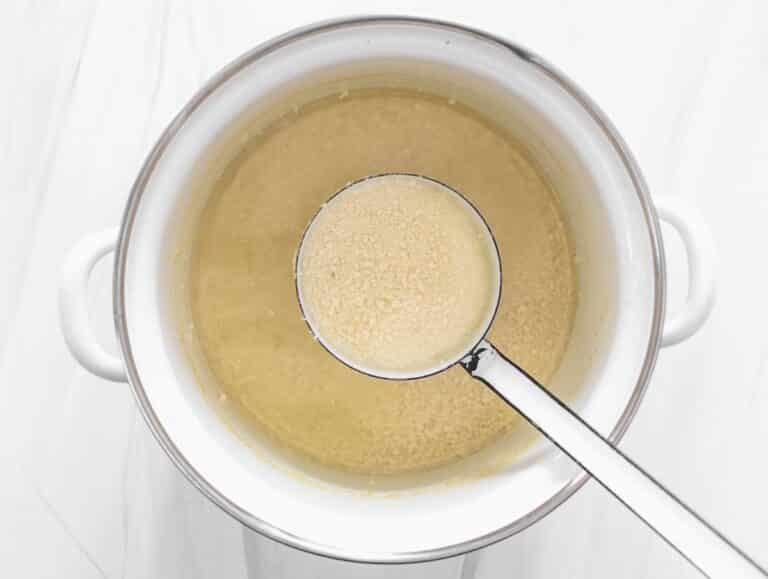
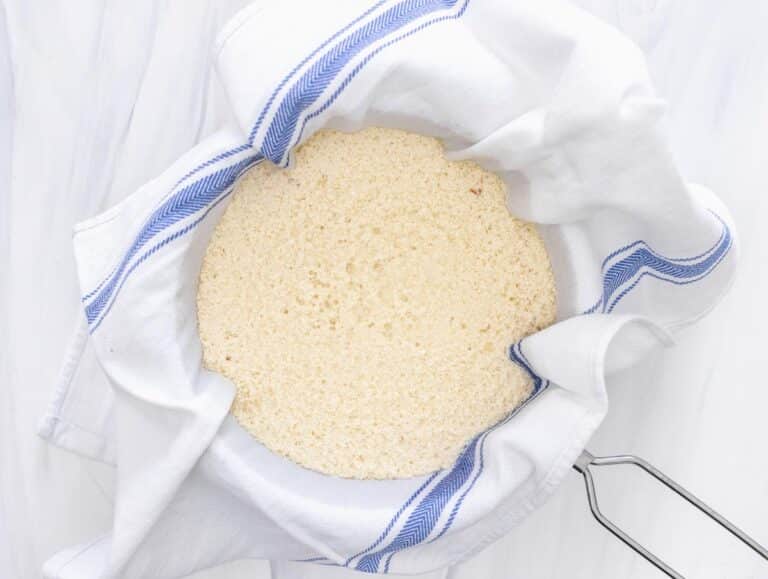
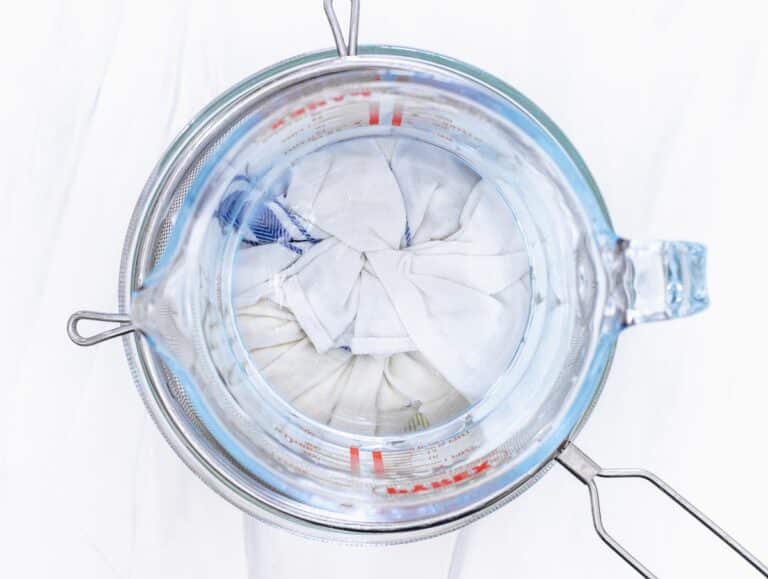
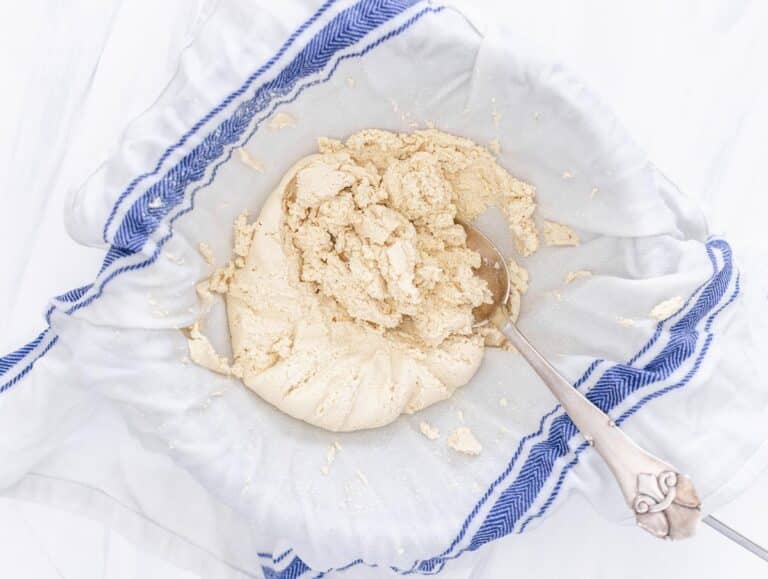
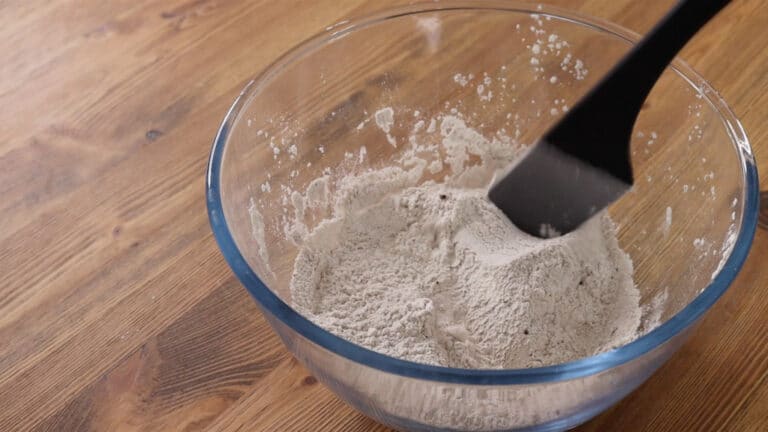
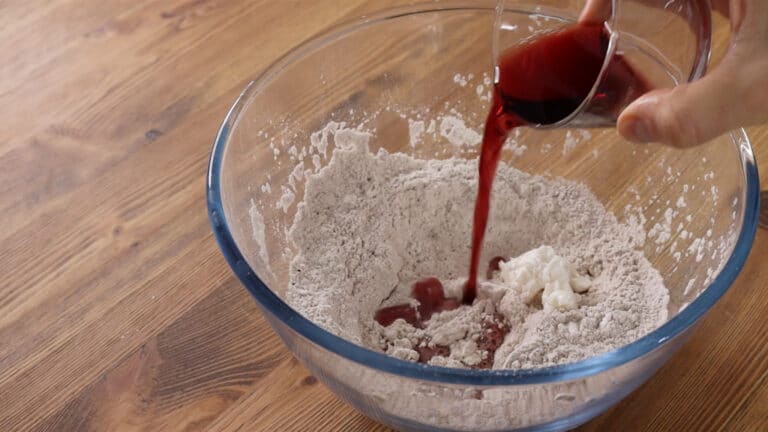
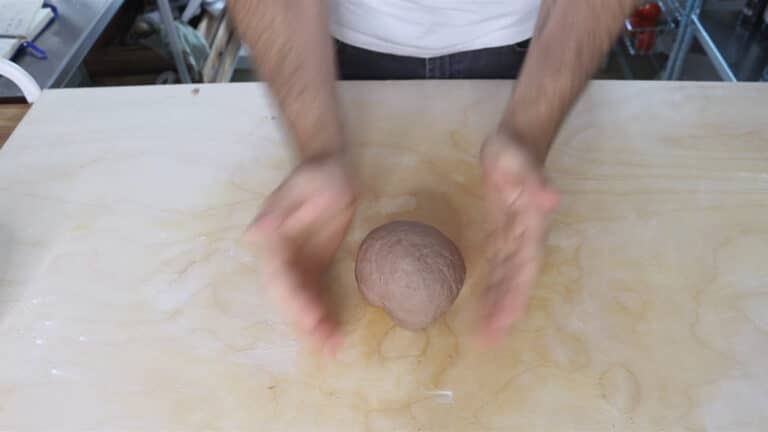
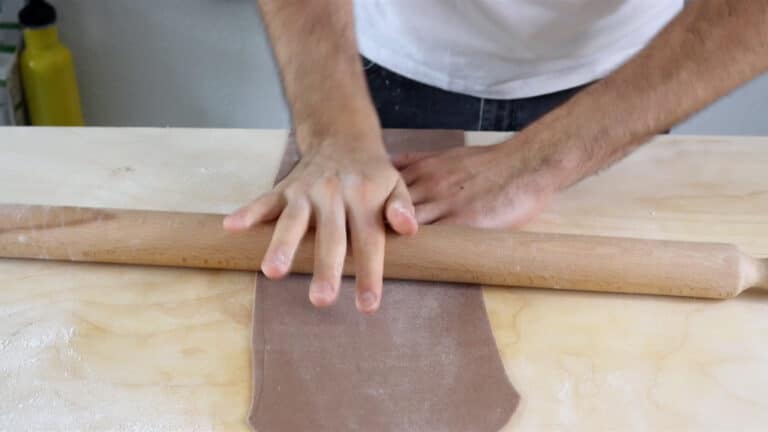
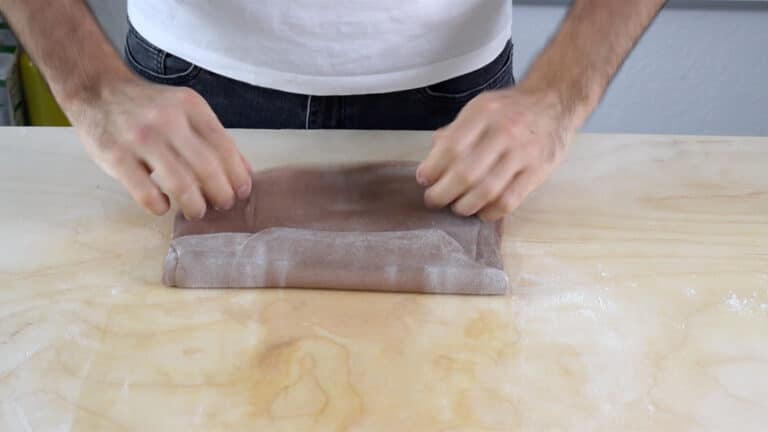
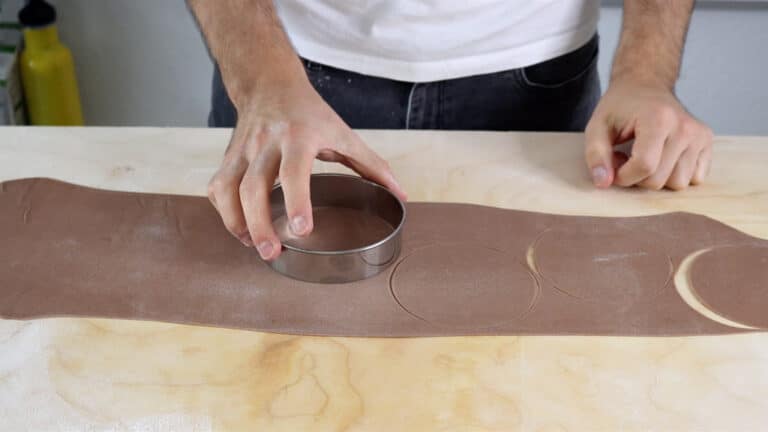
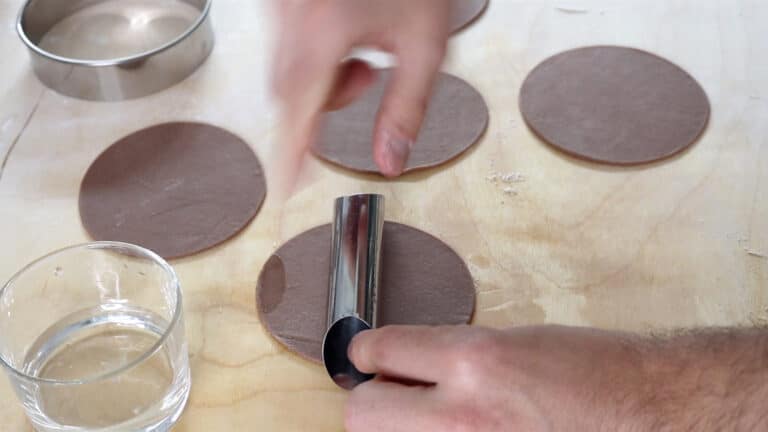
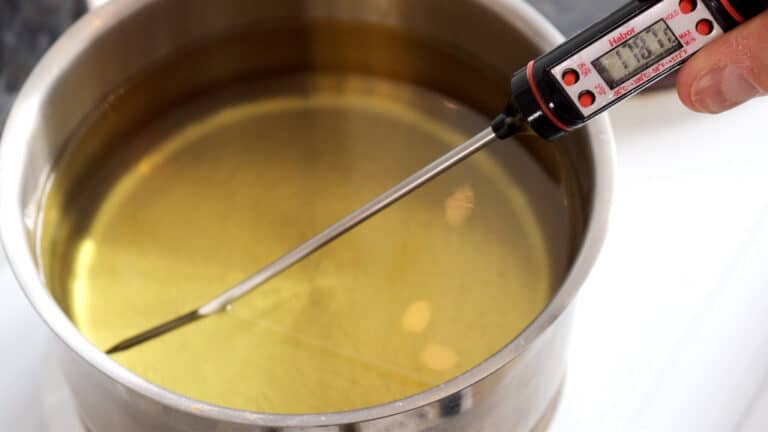

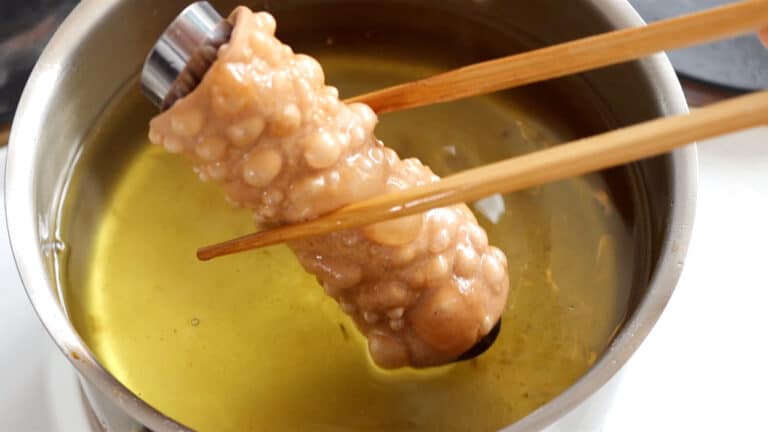
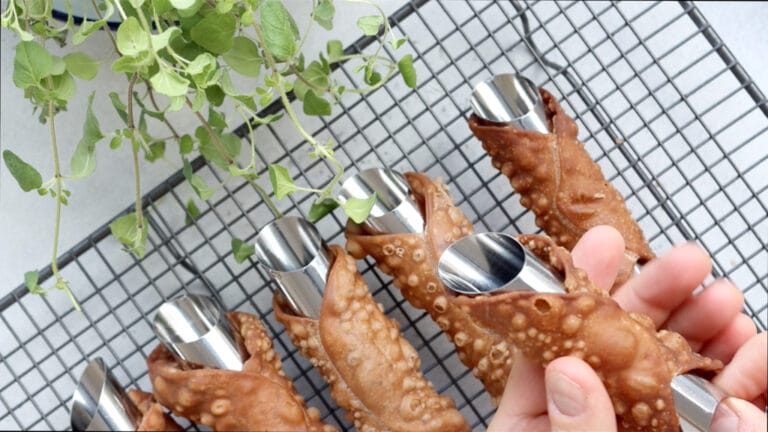
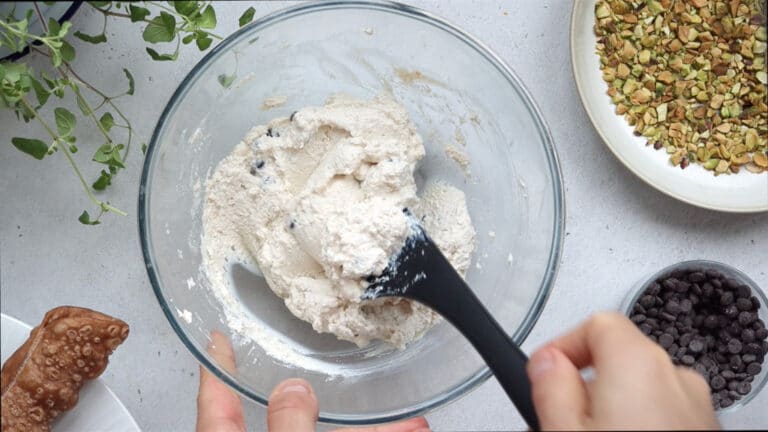
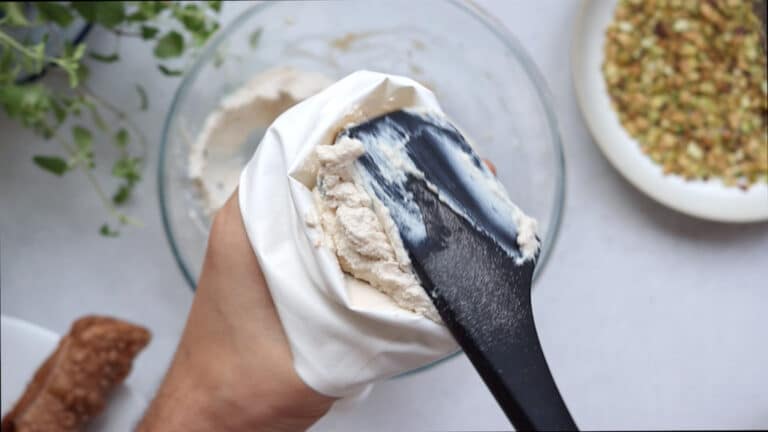
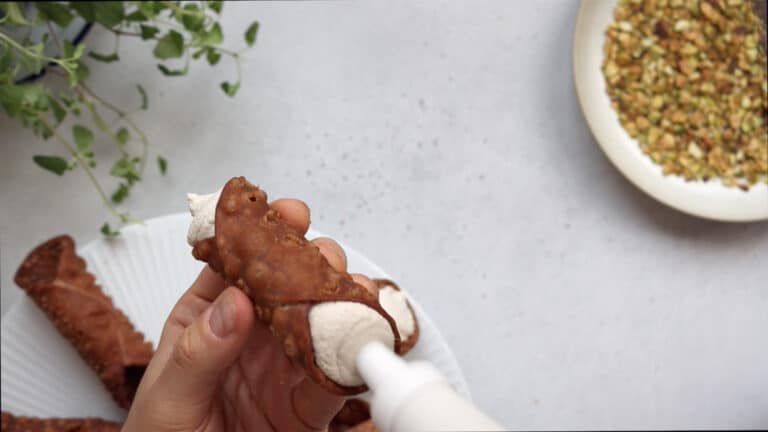

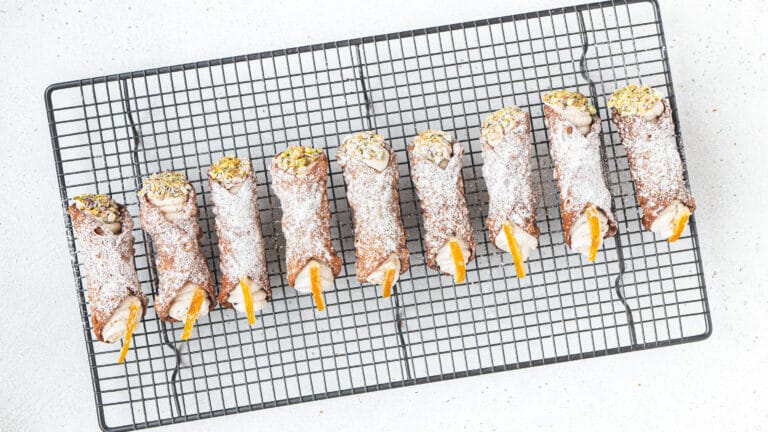
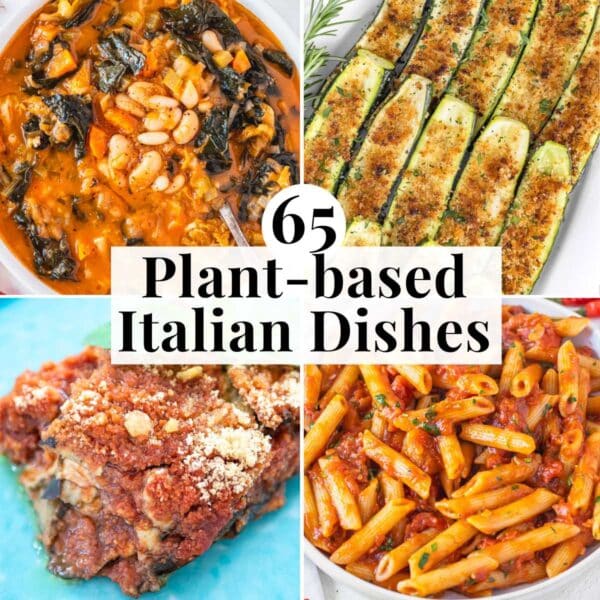

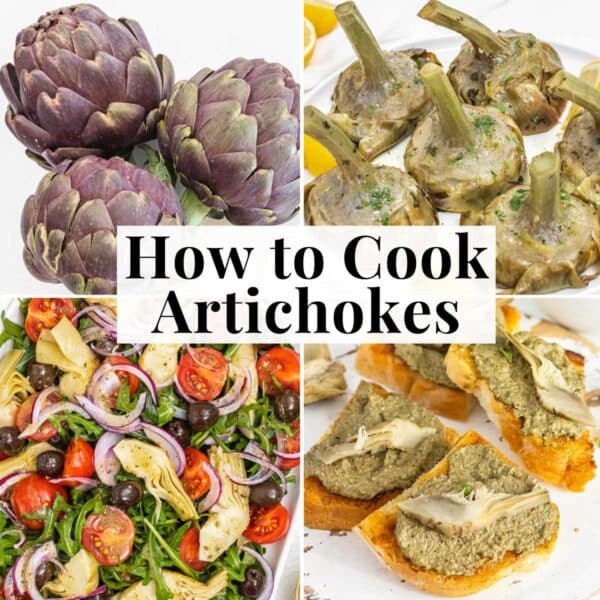

I’m excited to make this! I know it’s not traditional, but I’d like to add a little flair with some almond/pistachio flavoring. I was thinking of adding a bit of almond extract to the ricotta recipe with the pistachios on top – do you think that would turn out well? Could I also sweeten the filling a little? Thanks!
Hi Sierra,
Yes you can certainly add almond extract, it sounds delicious (and it’s fantastic with grated orange zest which we also recommend adding).
As for the sweetening, you can add easily add 0.5-1 tablespoon of extra sugar to the ricotta filling, just make sure to add a little at a time while you taste for sweetness 🙂
I hope this helps, happy baking ❤️
When you say 6.5 g of soy, do you mean 6.5 g of protein per cup? I checked several soy milk cartons in the grocery, non of them say the soy amount in the milk. They mention the protein per cup
Hi Anita,
that’s interesting. Where are you based. Over here in Italy and I think allover Europe they must write the % amount of soy.
If you can’t find it written anywhere then I’d just use a brand you trust 🙂 We tested over 30 brands and they all worked well 🙂
I hope this helps!
Nico
Thanks, Nico, I’ll go with Silk original soy milk (red carton). Maybe I am looking for it in the wrong place 🤔 Anyone in US, if you can, please help me. Do you know a brand that has the percentage of soy? I would love to know which brand you have had success with.
Just starting to make the dough for a trial. I would like to make 40-50 cannoli for my party next week.
Hey Nico
Making these today I can’t wait! I noticed the the ricotta recipes are a bit different. If you clink the ricotta cheese recipe link in the ingredient list it calls for only 2 1/2 Tbl vinegar.
The ricotta recipe listed with the ingredients list calls for 6Tbl vinegar. Which one is correct? Do they both work?
Hi Jenny,
Thanks very much for your comment.
Both ricotta recipes work, the one listed in the ingredients list for cannoli yields more ricotta as we are making about 16 cannoli.
The vegan ricotta recipe linked is “designed” for a cheese mold which means less quantity. I hope this helps 🙂
Let me know if you have any other questions. Kindest, Louise
Hi, I make my own vegan butter with soy milk, soy lecithin granules, coconut oil, will this work for the butter in recipe?
Hi Wendy, thanks so much for your comment. I have never baked with homemade vegan butter, but my guess is yes. As long as the texture is similar to that if store-bought vegan butter you will still get airy cannoli shells. I hope that helps a little. Have a great Friday, cheers Nico
Making the ricotta and I accidentally just used 1 tbsp instead of 1 tsp of salt!! Is that going to be okay or did I ruin it?
Hi Michelle, it’s hard to tell – I’ve never tried with 1 tablespoon of salt. But try tasting the ricotta first, and since you’re using it as cannoli filling, you would need to add a lot more sugar to the ricotta in order to balance out the salt. Let me know how you get on! Cheers, Nico